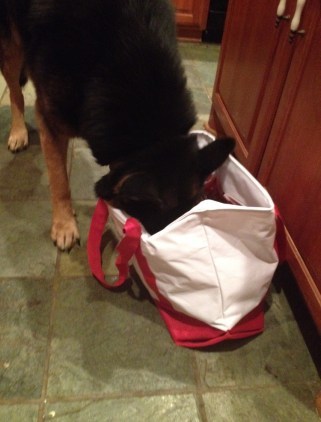Amy Shojai's Blog, page 86
December 22, 2015
SHOW AND TELL RELEASE! Pet-Centric Thriller Makes You Care

Winners of the NAME THAT DOG/CAT contest that appear in the book SHOW AND TELL. Enter to win your paw-tographed poster and bonus chapter! LEARN HOW HERE!
I am SO excited to announce that my third book in the September Day series is available today. And one of my favorite authors, Jon Land, has honored me with the following review–just Wow!
“SHOW AND TELL is one of those rare thrillers that hits you in the heart as well as the head. Amy Shojai hits the ground running and never slows down … damaged souls of both the two and four-legged variety join forces to rescue others along with themselves. Riveting, wholly satisfying …makes us care.” —Jon Land, USA Today bestselling author of Strong Light of Day
I hope y’all enjoy reading this story as much as I did writing it. I’m still waiting to get my copies of the book, and when they get here, I’ll ship to the winners of the NAME THAT DOG/CAT contest as well as the 10 winners from the Goodreads give-away.
And if you decide to write an honest review, please shoot me an email with the link to amy@shojai.com and I’ll send you a bonus chapter and maybe a paw-tographed limited edition poster, above (first come, first served).
ORDER HERE!
Barnes and Nobel (Nook & Print)
____________________________________________________
An animal behaviorist and her service dog race a deadly storm to expose a treacherous secret others will kill to protect.
A BLACKMAILER returns to sell a deadly cure.
A MOTHER’S DENIAL dooms millions of children.
AND A DOG shows true loyalty…when he runs away.
With her stalker finally caught, animal behaviorist September Day’s PTSD has abated and she’s begun to trust again. She dares to hope Detective Jeff Combs might become more than a friend, until his investigation into a dog fighting ring leaves her reeling.
Shadow wrestles his own demons. A German Shepherd autism service dog before losing his-boy to a health crises, Shadow found love and his true purpose working with September. Now his-boy is back–but changed–and Shadow fears he’ll be forced to choose.
When a desperate mom demands help, and Combs’s son disappears with his dog, September and Shadow must find the children before a devastating storm hits. But the children have a secret plan of their own. Only when September shows true courage, and a good-dog tells the truth, can they find their way home again.
I love hearing from you, so please share comments and questions. Stay up to date on all the latest just subscribe the blog, “like” me on Facebook,and get a FREE BOOK when you sign up for Pet Peeves newsletter. Want th e insider info on the latest books and appearances? Join my team and get advance sneak peaks related to my THRILLERS WITH BITE!
December 18, 2015
Poison Alert! 199 Pet Poisonous Plants & What to Do
‘Tis the season for decking the hall with garlands and more. I received an email from ProFlowers.com with this great infographic to share, and it seemed particularly timely.
Of course, my advice is to keep toxic plants out of the house entirely when you have pets (or toddlers!) eager to taste-test everything. Accidents do happen, though, so this is a handy guide to bookmark (and share!) with other pet parents.
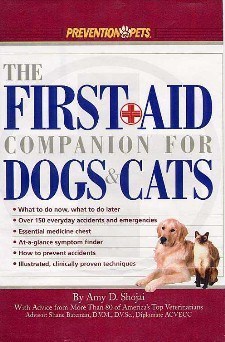 Meanwhile, why not keep an emergency kit on hand? My go-to is the First-Aid Companion for Dogs & Cats not only for poisons, but for everything from torn nails to (gasp!) gunshots or snakebite. It’s a good time to “gift” the pet people in your life, too…although my wish for you and your pets is that you’ll NEVER need the emergency advice!
Meanwhile, why not keep an emergency kit on hand? My go-to is the First-Aid Companion for Dogs & Cats not only for poisons, but for everything from torn nails to (gasp!) gunshots or snakebite. It’s a good time to “gift” the pet people in your life, too…although my wish for you and your pets is that you’ll NEVER need the emergency advice!
Have your pets ever “snacked” on something toxic? Do tell! What happened? what did you do…and what would you advise others based on your experience?
December 7, 2015
How to Create A Cat-Safe Christmas Tree

Create a cat safe tree your kittens and cats will leave alone–or can safely play with.
The Christmas tree might as well be an early holiday gift to your cats. Kitty can’t resist the urge to sniff, cheek rub, claw—and scale the branches to reach the highest possible perch. Don’t blame your cat. It’s normal for cats to compete for the top spot (literally and figuratively) to secure their place in kitty society. Youngsters won’t care about social standing, but high energy kitten play turns the holiday tree into a jungle gym. Tree encounters of the kitty kind not only risks breaking your heirloom ornaments, your furred family members can be injured by chewing or swallow dangerous items. Rather than fight a losing battle to keep cats at bay, create a second cat-safe tree with these 12 tips, so the fur-kids can enjoy the holidays as much as you do.
Cats turn anything into toys, even Christmas ornaments.
• Put yourself in your cat’s “paws.” Satisfy her desire to claw, lounge on branches, and trust that it won’t tip over under her assault. Match the tree size, sturdiness, base (perhaps add guy-wires for steadiness) to the activity level and number of cats.
• Ditch the lights, and any “fake-snow” flocking that can be chewed or swallowed. Instead, decorate with cotton balls or pillow-stuffing fleece for that snowy look on branches or around the base. If you’ve chosen a real tree, water with plain water and no additives in case kitty decides to drink.
• Strings and garland look great on the tree, but prove deadly inside a cat when swallowed. Dried flowers like baby’s breath look lovely and are nontoxic even if clueless kittens nibble.
• To increase the fun factor, insert a few sprigs of dried catnip—but be prepared for the cats to dismantle the tree!
• Catnip toys make great kitty tree decorations and won’t be destroyed during the feline assaults. Use “orphan” socks (singletons without a mate), fill with the ‘nip, and knot the open end.
• Jingle bells (quarter size or larger) can’t be swallowed and offer movement and sound when hung from ribbon on a branch. Put one inside the sealed catnip sock for more jingly fun.
• Furry toy mice come in bright colors—or go with a standard white theme—and can be placed in the branches for your mouse-aholic feline.
• Craft stores offer inexpensive bags filled with soft pompoms in a variety of colors and sizes—even sparkly ones. Cats love to play with these. Pompoms are so cheap you can fill the branches with one color theme, or a rainbow approach.

It’s not just the ornaments, but the electrical lights that can cause dangerous burns or death if chomped. Even the pine needles can cause injury if swallowed.
• Many cats adore feathers, but remember they can chew and swallow these. As long as supervised, a few feathers placed in the tree can be a fun accent as well. How about a bright feather boa instead of garland?
• Small stuffed toys—kitty theme or otherwise—appeal to many cats. Place around the base of the tree. Feline puzzle toys filled with special treats also are fun.
• Don’t forget the “cheap thrills.” Empty boxes, wads of holiday paper, and even paper shopping bags thrill cats. Remove bag handles so the cat won’t get hung around her neck.
• Toss a few special kitty treats in the boxes or bags. The smellier the treat, the better cats like them.
Be prepared to re-decorate the tree after the cats have fun. But a “Cat-mas” tree not only answers your kitty’s Santa Paws prayers, it means she’ll be more likely to leave your formal tree and decorations alone. That promotes a merry Christmas for the whole family, furry and otherwise.
What have I missed? How do you keep the holidays safe for your cats? Have you ever had a cat-astrophe with your tree? Do tell!
I love hearing from you, so please share comments and questions. Stay up to date on all the latest just subscribe the blog, “like” me on Facebook,and get a FREE BOOK when you sign up for Pet Peeves newsletter. Want th e insider info on the latest books and appearances? Join my team and get advance sneak peaks related to my THRILLERS WITH BITE!
November 29, 2015
Bright Mind Feeds Dog Brains #Betterwithpets #ad
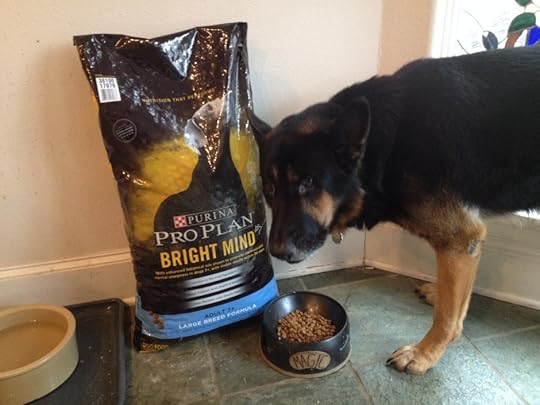
Magic loves being scientific…and testing new treats (I mean…food)!
This post is sponsored by Nestle Purina® and the BlogPaws Professional Pet Blogger Network. I am being compensated for helping spread the word about the BetterWithPets campaign but Bling, Bitches & Blood only shares information relevant to our readers. Purina is not responsible for the content of this article.
On November 3rd, I was pleased to attend the 3rd Nestle Purina #BetterWithPets event held in Brooklyn, NY, an all day event offered that several panels in the morning, which I blogged about here. Panels were followed by afternoon experiential hands-on exhibits, and that’s the focus of today’s blog. Everything was designed with the intention of “Exploring the best ideas for bringing people and pets closer together.”
Those who follow my blog know that I live with three pets: Karma-Kat (my youngest at age two); nine year old Magical-Dawg; and my Siamese wannabe, Seren, who will celebrate her 20th birthday in February. Aging pets strike a chord with pet people, having shared so much time and love with us–but all of us worry not only about physical challenges but the heartbreak of cognitive changes. We remember the youthful exuberance, joyful play, and sharp attention to everything–and when that begins to fade, it hurts your heart especially when partnered with that puzzled look of incomprehension in the pet’s eyes.
I’ve written about cognitive challenges in pets many times here on the blog and in my aging pets books, so I was intrigued and delighted to learn more about one special topic/exhibit at the Better With Pets summit. Purina’s top scientists have studied the effects of brain aging, discovered how enhanced botanical oils benefit the brain, and have incorporated MCTs into ProPlan BRIGHT MIND™ dog food (for dogs age 7 ).
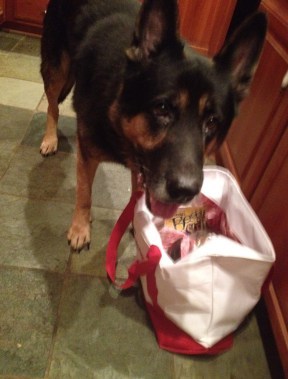
Any “gift bag” I bring home from events get the once-over from Magic.
I wanted to blog about this immediately, and even have a short interview in the video (below) from Dr. Janet Jackson and Dr. Yuanlong (Gary) Pan recorded during the event. I’ve known Dr. Jackson for many years, having interviewed her a number of times for articles and books–we were both “mentors” and co-columnists on an educational online site for many years. Dr. Jackson joined the company in 1990 and today is the Vice President of Nutritional Research at Nestle Purina PetCare. Dr. Pan is a Senior Research Scientist at Nestle Purina and joined the company in 2000, and focuses on developing specific nutrients to promote brain health and function in pets.
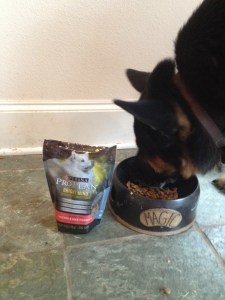
I used the sample bag of Bright Mind to spike Magic’s regular food and help with transitioning to the new diet. No problem…he LOVES it!
I delayed blogging about this until I received promised information from ProPlan brand manager Lisa Pacatte. She kindly sent me a Bright Mind Trial Program kit last week. It included coupons to try the food, which I purchased at PetsMart, and instructions about how to transition Magic to the new diet, and ways to document any potential changes. Oh, and Magic is DELIGHTED to get to try out new food–the small sample I brought home from the Better With Pets summit has already been gobbled up like treats. Note: it’s important to transition your dog to any new food to avoid potential upset tummies.
DOG BRAIN HEALTH & BRIGHT MIND?
Aging is a type of biological rust, but feeding the body correctly offers protection and, dare I say, a type of beneficial oil that keeps all the gadgets moving smoothly, including the brain. The brain is primarily fueled with glucose but by about age seven, the glucose metabolism in the brain begins to change. These changes can be very subtle to more noticeable, depending on the individual dog. In general terms, though, this can affect memory, learning, awareness, and/or decision-making. You might notice your older dog isn’t quite as “mentally spry” as in the past, or his youthful prompt response to requests now take longer to process and achieve.
Studies have shown that adjusting the nutrient profiles in pet food–adding antioxidants, for example–can have a beneficial or protective effect on brain function. Since 2003, Purina has sought to find an additional energy source for the brain that could be more easily and efficiently metabolized than glucose. By providing this additional energy supply, scientists hoped the brain would function in a more youthful fashion.
Triglicerides are the building blocks of fats, but different kinds of fat include different types of triglycerides. When specific kinds of triglicerides (from palm kernel oil and coconut oil) were modified to consist primarily of medium-chain triglyceride vegetable oil (MCTs), they transformed into a highly effective energy source for the brain cells or neurons. In effect, “feeding the brain” appropriately with MCTs appears to slow brain aging or even turn back the clock for dogs, improving interaction with owners, interest in playing, and ability to adapt and cope with change.
Dogs in the Purina Bright Mind feeding study showed changes in their cognitive abilities in as little as thirty days. Scientists measured the dogs’ ability to remember things–finding a hidden toy, for example–as well as ability to learn new behaviors. Bright Mind not only addresses brain health with MCTs, it is also formulated for the needs of aging dogs to be highly digestible, with higher levels of antioxidants, and a bit less fat to reduce the potential “pudge” factor. You can find out more at the BrightMindEffect.com website.
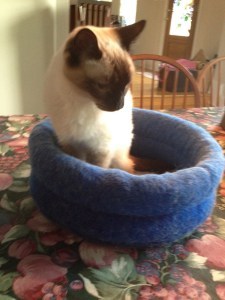 I’ll keep a log of Magic’s Bright Mind journey, and report back in thirty days or so. Meanwhile, I’m anxious for Seren to get her chance at a similar product, which I understand is already available in parts of Europe. Wouldn’t that be a nice 20th birthday present for Seren?
I’ll keep a log of Magic’s Bright Mind journey, and report back in thirty days or so. Meanwhile, I’m anxious for Seren to get her chance at a similar product, which I understand is already available in parts of Europe. Wouldn’t that be a nice 20th birthday present for Seren?
What about your pets–do you feed your senior dogs and cats differently? Why/why not? Have you noticed any changes in your pets’ mental acuity? If the MCTs work for pets, would you want to put it in your foods, too? Do tell!
I love hearing from you, so please share comments and questions. Do you have an ASK AMY question you’d like answered–click the banner in the sidebar. Stay up to date on all the latest just subscribe the blog, “like” me on Facebook,and get a FREE BOOK when you sign up for Pet Peeves newsletter. Want the insider info on the latest books and appearances? Join my team and get advance sneak peaks related to my THRILLERS WITH BITE!
November 24, 2015
How To Pet Proof Your Holidays with 11 Life-Saving Tips

Pet proof your holidays to keep your fur-kids safe!
Do you pet proof for the holidays? Thanksgiving weekend seems to be a popular time to break out the holiday trimmings, not just in terms of munchies, but decorations, too.
Holiday homes become pet playgrounds at this time of year. Cats delight in un-decking the halls and climbing the tree. Dogs eat decorations and baptize the tree. The result is a Christmas that’s anything but merry. Refer to these tips to keep your pets safe and your holiday happy.
Plants and Pets. Dogs and especially puppies chew nearly anything. Cats rarely eat plants, but they do claw them and then lick/groom away the residue. Beware of holiday floral arrangements that contain pet dangers. Lilies can cause kidney failure. Holly and live mistletoe cause nausea, vomiting, diarrhea and lethargy if ingested by your pet. Poinsettias are NOT deadly but can cause nausea and/or mild vomiting. Choose pet-safe plants and set them out of paw-reach. Or consider using silk or plastic holiday plants make an equally showy statement without the poison potential.
Fire Hazards. Fireplaces offer extra warmth and atmosphere to holiday gatherings, but can prompt singed whiskers or burned paws. Candles prove irresistible especially for kittens who paw-test everything to see what it is, or meet it head-on to sniff and explore. That’s not just painful for pets, it’s a fire hazard for your entire family should Fluffy knock over the Menorah. Instead, electric candles are available for decorating purposes. If you must have the real thing, ensure pets are safely out of the way and candles out of paw-reach. Be sure the fireplace screen is secured against curious pets, too.
Toxic Treats. Gobbling any sort of candy may cause vomiting and/or diarrhea.
Chocolate poses special dangers. Too much chocolate, which contains a stimulant called theobromine, can kill your pet. Keep holiday candy out of reach, in latched cupboards, to keep your canine glutton from over-indulging.
Xylitol is used as a sweetener in many products, including gum, candy, baked goods and toothpaste. It can cause insulin release in most species, which can lead to liver failure. The increase in insulin leads to hypoglycemia (lowered sugar levels). Affected pets may vomit, act lethargic or uncoordinated and these signs may progress to seizures.
Macadamia nuts can cause weakness, depression, vomiting, tremors and hyperthermia in dogs. Signs usually appear within 12 hours of ingestion and can last approximately 12 to 48 hours. Almonds, pecans and walnuts have so much fat in them, they can cause diarrhea in dogs, or even lead to pancreatitis.
Grapes and raisins can cause kidney failure in dogs. Avocado can cause heart damage and death in pet birds.
Flavored aluminum foil, grease-smeared turkey strings, and cellophane candy wrappers can be dangerous to pets if swallowed—dogs and cats rarely unwrap treats before eating. Eating raw yeast bread dough also causes problems when the dough rises in the tummy.
Christmas Tree Tips. Cats consider the tree a feline jungle gym with cat toys that swing, sparkle, and invite paw-pats and biting. Some dogs take “aim” at the tree just as they would your outside shrubs and baptize the greenery. Drinking from treated water in the base can poison pets. Eating tinsel and ornaments can prove deadly, and dogs often chew through electric chords with shocking results.
Smaller trees can be set on table tops, inside of baby play pens, or in a room protected by a baby gate. Situate breakable and dangerous decorations on the top of the tree out of reach of inquisitive pets.
Make the area around the tree unattractive to keep paws at bay. Clear plastic carpet protectors and place under the tree—nub side up. That makes cruising or lounging under the tree uncomfortable. The soft “tacky mats” available from home product stores designed to keep throw rugs from sliding around work well to keep small pets away because they dislike walking on sticky surfaces.
Use your pet’s smell sense to keep her away from the tree. Citrus scents are off-putting to cats so scatter orange or lemon peels (or potpourri) around the base of the tree. Vicks (menthol smell) also works as a good pet repellent. Dip cotton balls in the ointment and stick in the lower branches of your tree. They’ll look a bit like snow and blend in with the rest of the decorations.
Create a “pet safe” tree decorated with dog toys and catnip mice. Place these within paw reach on lower branches and reserve the off limits decorations for the top of the tree.
What other steps do you take to help keep your fur-kids safe during the holidays? Do tell!
I love hearing from you, so please share comments and questions. Do you have an ASK AMY question you’d like answered–click the banner in the sidebar. Stay up to date on all the latest just subscribe the blog, “like” me on Facebook,and get a FREE BOOK when you sign up for Pet Peeves newsletter. Want th e insider info on the latest books and appearances? Join my team and get advance sneak peaks related to my THRILLERS WITH BITE!
November 17, 2015
Pet Holiday Visits? 10 Tips to Keep Tails Wagging
Are pet holiday visits in your travel plans? Family gatherings are a big part of the holidays, and pets double the fun—and the stress.
Most cats hate strange environments, so a pet sitter is usually the best choice for kitty. If you know your cat does well on the road and during visits, plan ahead. Set up a “cat central” room in Grandma’s house with all the important kitty paraphernalia (litter pan, scratch post, etc.). Cats often require many days or even weeks to accept “new” pets, so for shorter visits, giving your visiting cat a private room away from the resident critters offers the best chance of a happy holidays.
10 TIPS FOR HOLIDAY PET VISITS
Many dogs love new places, though. Taking him along can save boarding costs. Besides, pets are part of the family, so we want to share our furry loves with relatives.
But when your King meets Grandma’s Sheba for the first time, how do you keep the fur from flying? How would you like a stranger sleeping in your bed, eating from your plate, or (ahem) using your toilet? Pet introductions can take days, weeks, or sometimes months to be successful, so don’t expect overnight miracles. Follow these 10 tips to keep the pets happy and safe, and stay on speaking terms with your relatives.
The Resident Pet “owns” the house and yard. Therefore, give him continued access to his territory.
Confine the Guest Pet in one room. Provide familiar bowls, beds, litter pans, and toys in the room where the owner sleeps. The owner scent helps keep the Guest Pet calm even when he’s alone, and confinement provides a familiar home base where he’s safe from the Resident Pet. Confining him behind a closed door also tells the Resident Pet that only part of her territory has been invaded. (This works for visiting kitties, too!)
Create good associations. Feed the pets on opposite sides of the closed door, or offer favorite toys or games. This helps each identify the other pet’s presence with “good stuff” and helps relieve tension.
Use baby gates. The see-through barrier allows the Guest Pet to be part of the gathering without trespassing on the Resident Pet’s turf. A baby gate also gives curious, friendly pets (especially dogs) a safe way to meet. Moveable baby gates can divide a hallway or stairs to segregate whole sections of the house when necessary.
Leash the guest dog. This keeps him under control around the resident pet. That’s especially important with a resident cat.
“Potty” dogs separately. Distract the Resident Dog with treats or a game out of sight when the Guest Dog must leave his room.
Supervise yard interactions. Once dogs experience friendly meetings through the door for a couple of days (no growls, or elevated fur—whines are okay), a nose-to-nose play meeting is possible. Be sure each dog’s owner is present.
Leash both dogs. Bring the Resident Dog out first because he “owns” the yard. Remove any toys, bones or other resources they might argue over.
Walk the leashed dogs parallel to each other on opposite sides of the yard, back and forth, slowly bringing them closer. Stop if you see tucked tail, growls, or fluffed fur—they aren’t ready to play. Play bows (“elevator butt” posture) buy the dogs a 5-10 minute off-leash game before separating them. Play time can be extended if they do well.
Don’t force interactions. When an adult kitty visits, she’ll be happy to stay in the room and wait for your visits. A resident cat also may simply disappear to a safe place in the house to avoid contact with strangers (human or furred).
It’s hard to predict first meetings. You don’t love everyone you meet—(especially weird Cousin Cylene!) so why should your pets be any different? If pets will only be together a few days, aim for management or tolerance. There will be time enough over future visits for pet-to-pet love to blossom.
I love hearing from you, so please share comments and questions. Do you have an ASK AMY question you’d like answered–click the banner in the sidebar. Stay up to date on all the latest just subscribe the blog, “like” me on Facebook,and get a FREE BOOK when you sign up for Pet Peeves newsletter. Want th e insider info on the latest books and appearances? Join my team and get advance sneak peaks related to my THRILLERS WITH BITE!
November 12, 2015
GoodReads GiveAway for Pet-centric Thriller: Show & Tell
 ENTER to win one of 10 Paw-tographed copies of the book in the GoodReads Giveaway, below.
ENTER to win one of 10 Paw-tographed copies of the book in the GoodReads Giveaway, below.
Chapter 1
Eighty pounds of German Shepherd vaulted onto her bed and startled September from a sound sleep. She froze, mouse-quiet in the dark. Her heart trip-hammered in concert with the dog’s low, bubbled growl that shook the bed, the vibration more felt than heard.
The downstairs clock struck five times. Clouds moved aside for moonlight to spill through the wooden blinds, casting stark silver and black shadows. The dog leaned closer. White-bright fangs glistened from his sooty muzzle, and September didn’t need to see Shadow’s expression to understand the dog’s warning.
Shadow had good reasons for everything he did. He’d saved her life more than once. . .
Now available for pre-order here.
Goodreads Book Giveaway

Show and Tell
by Amy Shojai
Giveaway ends December 15, 2015.
See the giveaway details
at Goodreads.
Don’t forget about the BONUS MATERIAL (poster & extra chapter) available, learn more here.
I love hearing from you, so please share comments and questions. Do you have an ASK AMY question you’d like answered–click the banner in the sidebar. Stay up to date on all the latest just subscribe the blog, “like” me on Facebook,and get a FREE BOOK when you sign up for Pet Peeves newsletter. Want th e insider info on the latest books and appearances? Join my team and get advance sneak peaks related to my THRILLERS WITH BITE!
November 9, 2015
Calling All Dog & Cat Lovers: SHOW & TELL Bonuses!
The next book in the September Day series, SHOW AND TELL, will release DECEMBER 22, 2015. Read on to find out how to get your copy of the paw-tographed limited edition poster (above) and an extra dog-viewpoint BONUS CHAPTER.
PLEASE SHARE this post with others who enjoy nail-biting pet-centric stories of suspense.
Now available for pre-order here.
An animal behaviorist and her service dog race a deadly storm
to expose a treacherous secret others will kill to protect.
A BLACKMAILER returns to sell a deadly cure.
A MOTHER’S DENIAL dooms millions of children.
AND A DOG shows true loyalty…when he runs away.
With her stalker finally caught, animal behaviorist September Day’s PTSD has abated and she’s begun to trust again. She dares to hope Detective Jeff Combs might become more than a friend, until his investigation into a dogfighting ring leaves her reeling.
Shadow wrestles his own demons. A German Shepherd autism service dog before losing his-boy to a health crises, Shadow found love and his true purpose working with September. Now his-boy is back–but changed–and Shadow fears he’ll be forced to choose.
When a desperate mom demands help, and Combs’s son disappears with his dog, September and Shadow must find the children before a devastating storm hits. But the children have a secret plan of their own. Only when September shows true courage, and a good-dog tells the truth, can they find their way home again.
BONUS #1: WIN THE POSTER
As y’all know, the winners of the have their pets featured in the book–and it’s an incredibly exciting story with tornadoes, flash floods, bad guys, Pit Bulls, and heroic pets & kids. The poster (above) includes pictures of the NAME THAT DOG/CAT winners…yes, the real pets, with their human-mom names as well. This is a limited edition poster that will be paw-tographed.
NOTE: Once posters are gone, they’re gone…so be among the first to enter in order to get your copy.
BONUS #2: WIN THE EXTRA CHAPTER
An extra chapter, written in Shadow’s viewpoint, includes the runners-up of the Name That Dog/Cat contest: the dogs Thor, Buster, Bo and Freckles, and the cats Lucy, Truffle, Caster and Einstein. This chapter also introduces two main characters of my forthcoming Lei Crime Kindle World novella, which will include Keiki, the Rottweiler puppy. There’s no limit on the number of times I can share this bonus chapter.
HOW TO WIN YOUR BONUS
You can win one or both of these bonus gifts. Here’s what to do.
Read the book

Post an honest review to one or more (Amazon, Barnes & Noble, GoodReads, iBookStore, Kobo, and/or your BLOG).
Note: Reviews can’t be posted to online stores until the December 22, 2015 release, but advance reviews may be posted to GoodReads or blogs
Email me the URL of your honest review with “SHOW AND TELL BONUS” in the subject line.
For all my dog and cat blogger peeps out there–please message me or post a comment here if you’d like to receive an  ARC of the book for possible advance review. I hope to have some “exclusives/extras” (excerpts, interviews, Q&A, etc.) for bloggers interested in helping with the launch. :0
ARC of the book for possible advance review. I hope to have some “exclusives/extras” (excerpts, interviews, Q&A, etc.) for bloggers interested in helping with the launch. :0
THANK YOU PURRS and virtual wags to everyone who has made my fiction journey thus far such a wonderful success. The first book (75 starred reviews and counting!) would not have launched a series without such incredible reader support.
If you’ve not already fallen in love with September and good-dog Shadow, you may want to check out the first two books in the series, LOST AND FOUND and HIDE AND SEEK.
I love hearing from
 you, so please share comments and questions. Do you have an ASK AMY question you’d like
answered–click the banner in the sidebar. Stay up to date on all the latest just subscribe the blog, “like” me on Facebook,and get a FREE BOOK when you sign up for Pet Peeves newsletter. Want th
e insider info on the latest books and appearances? Join my team and get advance sneak peaks related to my THRILLERS WITH BITE!
you, so please share comments and questions. Do you have an ASK AMY question you’d like
answered–click the banner in the sidebar. Stay up to date on all the latest just subscribe the blog, “like” me on Facebook,and get a FREE BOOK when you sign up for Pet Peeves newsletter. Want th
e insider info on the latest books and appearances? Join my team and get advance sneak peaks related to my THRILLERS WITH BITE!
November 6, 2015
Purina & #BetterWithPets Is A Furry Winner Bringing People & Pets Together
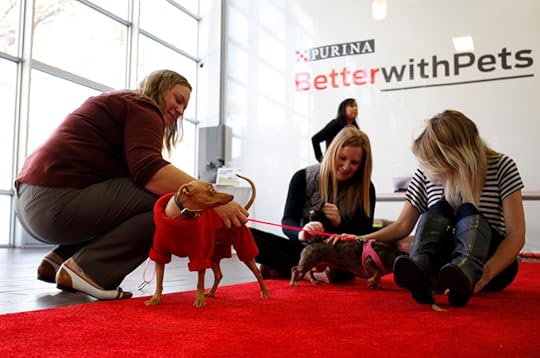 This post is sponsored by Nestle Purina® and the BlogPaws Professional Pet Blogger Network. I am being compensated for helping spread the word about the BetterWithPets campaign but Bling, Bitches & Blood only shares information relevant to our readers. Purina is not responsible for the content of this article.
This post is sponsored by Nestle Purina® and the BlogPaws Professional Pet Blogger Network. I am being compensated for helping spread the word about the BetterWithPets campaign but Bling, Bitches & Blood only shares information relevant to our readers. Purina is not responsible for the content of this article.
This past Tuesday, November 3rd, I was pleased to attend the 3rd Purina #BetterWithPets event held in Brooklyn, NY. I was able to attend the first one a couple of years ago, and had a conflict last year so was delighted to be invited again. This all day event offered several panels in the morning, followed by afternoon experiential hands-on exhibits (which I’ll blog more about later). Everything was designed with the intention of “Exploring the best ideas for bringing people and pets closer together.”
 The whole day was a slam-dunk for cats and dogs, and the people who love them. Bravo to Purina for truly bringing together some for the brightest minds in pet science and culture–and allowing pet advocates, media, shelter professionals and more to mingle, ask questions, and share information to improve pet well being. The event was a who’s who of movers and shakers in the pet world, and I had fan-girl moments all day getting to meet (and reconnect) with my heroes.
The whole day was a slam-dunk for cats and dogs, and the people who love them. Bravo to Purina for truly bringing together some for the brightest minds in pet science and culture–and allowing pet advocates, media, shelter professionals and more to mingle, ask questions, and share information to improve pet well being. The event was a who’s who of movers and shakers in the pet world, and I had fan-girl moments all day getting to meet (and reconnect) with my heroes.
Those who know me won’t be surprised that there were quite a few Kleenex moments throughout the day…I weep pretty easily especially when it comes to pet topics. The opening keynote by Dr. Arleigh Reynolds, and the ending short movie that also covered his subject, were wonderful tributes for and about the Frank Attla Youth Program that benefits at-risk students in rural Alaska–and how dogs brought a community back to life when everyone in the family learned they had a role to play in caring for the dogs.
 In his talk, Dr. Reynolds said during his studies, he learned about tidal pools where a multitude of different creatures live alongside each other. “If you remove one, before long several others disappear, even though their relationship isn’t clear.” He says the same thing is true with dogs. “Our relationship goes far deeper than what we can define. Humans and dogs are physically and emotionally healthier when we share our lives together.” When you get the chance, take a look at this brief movie:
In his talk, Dr. Reynolds said during his studies, he learned about tidal pools where a multitude of different creatures live alongside each other. “If you remove one, before long several others disappear, even though their relationship isn’t clear.” He says the same thing is true with dogs. “Our relationship goes far deeper than what we can define. Humans and dogs are physically and emotionally healthier when we share our lives together.” When you get the chance, take a look at this brief movie:
 It was particularly refreshing to have CAT interests so well represented. The first panel was moderated by Hal Herzog, Ph.D. and titled “An Evolving Relationship with Cats?” Dr. Herzog was joined by behaviorist Dr. Sandra Lyn; Mikel Delgado, CCBC; and Christina Ha, the co-founder of Meow Parlour. A few nuggets that came out of this session:
It was particularly refreshing to have CAT interests so well represented. The first panel was moderated by Hal Herzog, Ph.D. and titled “An Evolving Relationship with Cats?” Dr. Herzog was joined by behaviorist Dr. Sandra Lyn; Mikel Delgado, CCBC; and Christina Ha, the co-founder of Meow Parlour. A few nuggets that came out of this session:
We’re shifting how we work and how we communicate, so makes sense that the relationship may change.
Most of those visiting Meow Parlour are female millennials and found Meow Parlour through social media.
In past dog people could hang out together at dog parks with other dog lovers. Now cats and cat lovers can do the same thing with social media and cat cafes.
31 percent of millennial’s households include cat.
Millennials are willing to spend more on cats than in the past.
Relationships work better when you let the cat initiate the interaction
Dog videos make you cry. Cat videos make you laugh. Can we use that as a platform in how we educate?
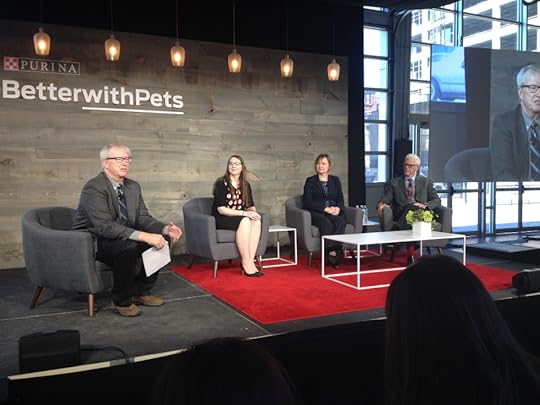 The second panel, “Stress, Our Pets and Us,” moderated by Dr. Marty Becker, featured Dr. Ragen McGowan, Heather Lewis, an architect/designer of vet hospitals and animal care facilities, and Dr. Tony Buffington. More nuggets from this session:
The second panel, “Stress, Our Pets and Us,” moderated by Dr. Marty Becker, featured Dr. Ragen McGowan, Heather Lewis, an architect/designer of vet hospitals and animal care facilities, and Dr. Tony Buffington. More nuggets from this session:
Cat and dogs see in different light spectrum, so offer enough space, a quiet place, and colors in their spectrum (blues/greens) that are soothing.
Cats and dogs like pastel colors best
Choice of lighting makes a difference in stress. Incandescent lighting and fluorescent are poor choices compared to the much better LED lights that are perceived more like natural sunlight.
Having a cat at a higher level changes the cat’s attitude and reduce stress–be sure cats get higher cage levels in vet clinics/shelters (and make options available in your home!)
Some stress is GOOD—such as puzzles or something to learn. Pets often CHOOSE to go with the more difficult challenge (a puzzle toy rather than full food bowl).
New “fear free” cages have horizontal bars and a place to “hide” the pet’s face at bottom. Vertical bars obstruct vision for the cats and cause added stress and horizontal provide unobstructed views.
Volunteers visiting pets in shelters for just 15 minutes lowers the dog’s stress significantly
 The third panel, “Raising Pets and Kids” was moderated by Dr. Zara Boland, and featured Jayne Vitale (North Shore Animal League), Stasha Becker (Photographer), behaviorist Dr. Ilana Reisner and Charley Bednarsh, director of Children’s Services, Brooklyn Family Justice Center. Additional nuggets from this great session:
The third panel, “Raising Pets and Kids” was moderated by Dr. Zara Boland, and featured Jayne Vitale (North Shore Animal League), Stasha Becker (Photographer), behaviorist Dr. Ilana Reisner and Charley Bednarsh, director of Children’s Services, Brooklyn Family Justice Center. Additional nuggets from this great session:
Dogs have been with people for 35-40 thousand years, in a symbiotic relationship that today goes beyond simple survival.
Are families evolving to fit pets needs, or are pets evolving?
Today it’s vital we teach children empathy as a skill.
Damaged kids identify with shelter pets–both may be orphans, homeless or have suffered terrible experiences. Pets allow kids to voice their fears and experiences
People are made up of memories, and pets can empower people during tragedy that “you can change for the better” and survive.
Stay tuned for the next blog on the “experiential” side of the event. And meanwhile, you can learn more at this link to #BetterWithPets.
I love hearing from you, so please share comments and questions. Do you have an ASK AMY question you’d like answered–click the banner in the sidebar. Stay up to date on all the latest just subscribe the blog, “like” me on Facebook,and get a FREE BOOK when you sign up for Pet Peeves newsletter. Want the insider info on the latest books and appearances? Join my team and get advance sneak peaks related to my THRILLERS WITH BITE!
October 26, 2015
Make Hide & Seek Fun and Safe with #NuzzleSmartCollar
Lots of y’all have read my dog-viewpoint thrillers and know how much I enjoy weaving fact among the thrilling fiction, with care, behavior and pet safety at the top of my list. When something I made up in my fiction becomes reality–as with Nuzzle® Smart GPS collar–I get shivers of delight. Read on…

Image courtesy of Nuzzle.
This post is sponsored by The Nuzzle Smart GPS Collar and the BlogPaws Professional Pet Blogger Network. I am being compensated for helping spread the word about the Nuzzle Indiegogo Crowd Funding Campaign, but Bling, Bitches & Blood only shares information relevant to our readers. Nuzzle is not responsible for the content of this article.
 In my second thriller HIDE AND SEEK, a fictional GPS pet tracking collar is instrumental in nailing the bad guy, with help from my canine hero. The technology was based on then-current kid products that were expensive, complicated to set up, cost a monthly fee, and had a limited two-mile effective range. But let’s face it…if your dog or cat takes off or gets picked up by do-gooders (or nefarious characters as in my fiction), two miles distance is nothing.
In my second thriller HIDE AND SEEK, a fictional GPS pet tracking collar is instrumental in nailing the bad guy, with help from my canine hero. The technology was based on then-current kid products that were expensive, complicated to set up, cost a monthly fee, and had a limited two-mile effective range. But let’s face it…if your dog or cat takes off or gets picked up by do-gooders (or nefarious characters as in my fiction), two miles distance is nothing.
The thought of lost pets gives me nightmares, how about you? Magical-Dawg has upon occasion “gone south” on us in pursuit of evil coyotes, teasing bunnies, or who-knows-what. Karma-Kat has perfected a door-dashing escape plan, and we lucked out when Magic managed to track and lure home our AWOL delinquent cat. In her youth, Seren-Kitty disappeared a time or two and gave us heart attacks before we realized she was in the house hiding (and snickering at our frantic antics). In other words, my premise for HIDE AND SEEK arose from real life fears.

Magic loves running…anywhere! and has multiple IDs just in case. Image copr. Amy Shojai, CABC
I’ve got multiple layers of pet ID on all my pets. Magic has an ear tattoo (now faded), and he and the cats have collars with tags and also are microchipped. I’m still a huge fan of these precautions, but for them to work, the pet first has to be found.
Imagine my delight to learn about Nuzzle, a GPS collar tracking system that’s waaaaay better than what my poor characters experienced with my made-up product. If you care about your pets’ safety, you owe it to them (and yourself) to check this out. You can follow them on Facebook here.

Image courtesy of Nuzzle.
Nuzzle uses a cellular network like your cell phone and has NATIONWIDE coverage (at short range it uses bluetooth), that integrates with the Nuzzle GPS Tracker App. You can define a “geo-fence” so the App sends you alerts if your pet moves out of those regions. All you do is put on the lightweight GPS collar, download the app, and then register your pet’s profile. If you prefer, you can also detach the Nuzzle tracker portion from the nylon collar and re-attach to your pet’s own collar or harness.
 Even if you have a homebody pet like my 19-year-old Seren-Kitty, you can keep track of activity when you’re away from home to see if she’s napping, or rearranging the furniture. Just imagine, you’ll be able to find your cat’s most secret hiding spot! That’s right, Nuzzle works on cats as well as dogs. The app is another nifty way to keep your pet’s health records in a handy, accessible location.
Even if you have a homebody pet like my 19-year-old Seren-Kitty, you can keep track of activity when you’re away from home to see if she’s napping, or rearranging the furniture. Just imagine, you’ll be able to find your cat’s most secret hiding spot! That’s right, Nuzzle works on cats as well as dogs. The app is another nifty way to keep your pet’s health records in a handy, accessible location.
There are no monthly fees, either. All that’s factored into the one-time price of the collar. In my thriller, the hero worries about battery life in the fictional device. The Nuzzle comes with two batteries so one can always be charging, and each battery lasts up to five days.

Nuzzle offers a great way to find pets that stray.
The pets featured in next book deal with being stolen, surviving tornadoes and flash flood, among other things. They sure could have benefited from a waterproof GPS tracking collar like Nuzzle. In fiction, it’s entertaining to read about heroic people and pets that overcome outrageous odds to survive and bring bad guys to justice.
In real life, though, we want to prevent angst. How better than with the peace of mind of a GPS tracking collar? The Nuzzle collar and Nuzzle GPS Tracker App is currently only available via an Indiegogo campaign here where you can get in on early bird packages. I did–and I can’t wait to get mine!
Has your dog (or cat) ever gone missing? What sort of identification do you have on them? Do you have a plan for recovering your wandering pet? Do tell! And please share this post, with others concerned about wandering pets.

COMING SOON!
I love hearing from you, so please share comments and questions. Do you have an ASK AMY question you’d like answered–click the banner, above. Stay up to date on all the latest just subscribe the blog, “like” me on Facebook,and get a FREE BOOK when you sign up for Pet Peeves newsletter. Want the insider info on the latest books and appearances? Join my team and get advance sneak peaks related to my THRILLERS WITH BITE!



